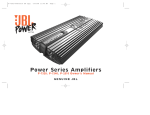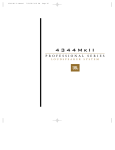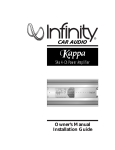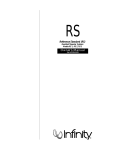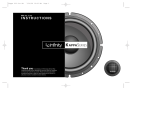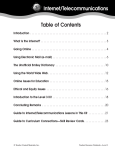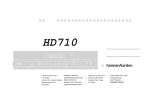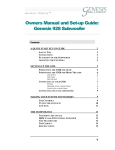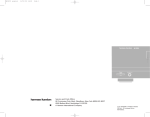Download Infiniti OMEGA 9301297-001 User's Manual
Transcript
OMEGA Owner’s Manual Part #9301297-001 ® TABLE OF CONTENTS Introduction..............................................................................................................................3 About This Product..............................................................................................................3 Unpacking ...............................................................................................................................3 Associated Components............................................................................................................4 Installation of Spikes.................................................................................................................4 Connections Using a Stereo Amplifier...................................................................................5–6 Connection for Bi-Amp Operation............................................................................................7 Bi-Wiring ..................................................................................................................................8 Positioning Your Speaker ....................................................................................................9–11 Room Acoustics, Speaker Positioning and Tonal Balance ..................................................12–13 Adjusting Your EMIT™ Level .................................................................................................14 Adjusting Your EMIM™ Level ................................................................................................14 Setting the Audio System Controls..........................................................................................14 Acoustic Feedback ..................................................................................................................15 Care of Your Speakers.............................................................................................................15 In Case of Trouble With Your Speakers...................................................................................15 Specifications ..........................................................................................................................16 INTRODUCTION ABOUT THIS PRODUCT... You have invested in one of the finest audio/video speakers available. Your Infinity Omega speaker employs new technology in driver, crossover and cabinet construction, which places it at the forefront of current speaker design. As with any high-quality product, special care must be taken to install and operate your new speaker. It is for this reason we suggest you read this manual carefully from cover to cover prior to installation. UNPACKING Upon opening the carton, inspect the speaker carefully for any sign of transit damage. If there is damage, immediately call your dealer or the trucking firm that made the delivery. Do not delay in reporting the damage because the longer you wait, the more difficult it will become to file a claim. We suggest that you fold the carton flat and store it for future use. Omega – Owner’s Manual ◆ 3 ASSOCIATED COMPONENTS Your Infinity Omega speaker is an extraordinary, highly musical system. Like all loudspeakers, it will reproduce distortion as well as music. For this reason, the choice of associated audio components is critical and should be made with care. If you are replacing existing speakers with an Infinity Omega System, there should be an audible improvement in sonic quality, assuming your other components are at least on a par with the Omega speaker in terms of low distortion, phase linearity, frequency response and so on. If no improvement is heard, or if the sound deteriorates, it is possible that one (or more) of your existing components is of a lower standard than your new Infinity speaker. When a speaker system is exceptionally revealing, musical colorations and other forms of distortion become more noticeable because these aberrations are no longer masked by the speaker. Here are some suggestions that will prove useful in obtaining a well-balanced audio system: • Employ an amplifier with as much power (current capability into an impedance of 4 ohms) as possible. Since quality speakers work best when driven by high current, the choice of an amplifier with a strong, adequate power supply and a heavy-duty and rugged output stage generally results in cleaner, betterdefined bass response. And, while low distortion, excellent phase characteristics and low noise are all extremely important performance parameters, sufficient power into a low impedance load (4 ohms or lower) on a continuous basis is equally important. • Another consideration is that a lower power amplifier operating at its maximum power output can damage a speaker more quickly that a high power amplifier playing at loud sound levels. This occurs because many amplifiers “clip” their output very “hard” when overdriven, creating high-frequency distortion, which can cause the voice coil of a tweeter to heat and eventually fail. Always choose an amplifier with high power. Your authorized Infinity dealer can best answer your questions and make recommendations. • The Omega speaker is extremely revealing and will quickly identify sonic anomalies within the listening system. Poor-quality speaker cables and component interconnects can add harshness, detract from spaciousness and reduce airiness surrounding instruments and voice. INSTALLATION OF SPIKES Please note that the speakers stand on spiked feet, which come with plastic caps installed to prevent injury to you and your belongings. The loudspeakers will perform best when the spikes make direct contact with the floor. If you wish to protect hardwood or other solid floors, leave the plastic caps in place. To level the speaker and to provide firm support at each corner on uneven floors, you can adjust the height of each foot by screwing it in or out of the bottom of the speaker. When installing the spikes, be very careful not to allow their sharp points to injure you or anyone helping you. 4 ◆ Omega – Owner’s Manual CONNECTIONS USING A STEREO AMPLIFIER OMEGA – + + EMIT flat - GOLD-PLATED SHORTING STRAP flat EMIM – + L.F. NORTHRIDGE, CALIFORNIA, USA Always turn off the power of your entire system before making connections to your speaker. Connect each speaker to your amplifier’s output terminals using the best wire you can obtain. The choice of speaker connecting wire is extremely important, especially when using speakers as sonically revealing as Infinity Omega. If inferior wire is used, sonic quality will suffer and the degradation of sound will be readily audible. For best results, do not use wire that is thinner than 16 gauge. NOTE: the lower the gauge number (16, 14, 12, etc.), the heavier the wire. Although gauge alone does not reveal the ultimate sonic quality of wire, it represents a good starting point, especially if you are not using a name-brand speaker connecting cable. Consult your dealer if you are not certain which type of wire will make your Infinity speaker sound best. When using regular lamp cord, look for ridges or different colored insulation to differentiate polarity. If there is a ridge on the outer insulation, use the ridge for positive (+) and the wire without the ridge for negative (-). If the insulation wrapped around one wire is red, use it for positive. Use white (or whatever the other color may be) for negative. (See figure 1.) Figure 1. Some examples of polarity coding on speaker cables. DIFFERENT COLOR CONDUCTORS RIDGE, STRIPE OR PRINTING, ONE LEAD ROUGH OR COLORED INSULATION, ONE LEAD It is important to connect your speakers in phase (which means that all individual drivers are moving in and out in the same direction and at the same time) in order to obtain the best localization of instruments and voice as well as the deepest, most natural bass. If a speaker is out of phase, the drivers in one channel will move in while the other channel will move out. This condition invariably results in sonic problems and must be avoided. Omega – Owner’s Manual ◆ 5 CONNECTIONS USING A STEREO AMPLIFIER (Continued) Using one length of speaker connecting wire, connect the RIGHT speaker to your amplifier’s (or receiver’s) RIGHT channel output terminals. Be sure that strands of the wire do not touch the ground terminal (and be sure to observe polarity). Even a thin stray wire can cause distortion in the system that would be very difficult to trace. Speaker Positive should be connected to amplifier Positive and speaker Negative to amplifier Negative. Connect the LEFT speaker to your amplifier’s LEFT channel output terminals in a similar manner. (See figure 2.) Figure 2. Speaker connection. OMEGA – + + EMIT flat - LEFT SPEAKER flat EMIM – - AMPLIFIER + L.F. NORTHRIDGE, CALIFORNIA, USA 6 ◆ Omega – Owner’s Manual – LEFT + RIGHT – + CONNECTION FOR BI-AMP OPERATION Your Infinity Omega speakers permit you to employ two power amplifiers in a bi-amp configuration. One amplifier feeds the woofer (the signal passes through the speaker’s crossover network to feed the woofer) and the other amplifier drives the remainder of the speaker system. This arrangement generally results in the purest and most open sound obtainable from the speaker. To connect your speaker to two amplifiers, merely remove the two gold-plated straps (which connect the bass and higher frequency section of the crossover network together for use with a single power amplifier) and connect one amplifier to the bass terminals and the other amplifier to the tweeter/midrange terminals. Observe polarity as detailed in the previous section. (See figure 3.) OMEGA Figure 3. Connecting the speaker for bi-amp operation. – AMPLIFIER + – LEFT + RIGHT – + + EMIT flat - flat EMIM – - AMPLIFIER + L.F. – LEFT + RIGHT – + NORTHRIDGE, CALIFORNIA, USA DO NOT ATTEMPT TO EMPLOY TWO SEPARATE AMPLIFIERS WITHOUT FIRST REMOVING THE SHORTING STRAPS ON THE REAR OF THE SPEAKER. DO NOT REMOVE THE SHORTING STRAPS WHEN USING ONLY A SINGLE POWER AMPLIFIER (except when bi-wiring; refer to the next section). If your amplifiers are not equal in power, always use the amplifier with the higher power (or greater current capability) to drive the woofers. When using two different amplifiers, it is recommended that at least one of the amplifiers has a level control that will permit you to set the level of one of the amplifiers to balance the other, resulting in equal output feeding the woofers and midrange/tweeter sections. Omega – Owner’s Manual ◆ 7 BI-WIRING Many audiophiles recommend using two connecting wires instead of one because two wires share current through a greater conducting area. If you wish to bi-wire your Omega speaker with a single power amplifier, remove the two shorting straps on the rear of the speaker that separate the woofer and midrange/tweeter sections of the crossover network. Two parallel speaker wires are connected to the amplifier’s output (for each channel) and the other ends of the wires are connected to the woofer and midrange/tweeter sections of the speaker. (See figure 4.) OMEGA Figure 4. Connecting the speaker for bi-wire operation. – + + EMIT flat - flat EMIM – - AMPLIFIER + L.F. NORTHRIDGE, CALIFORNIA, USA 8 ◆ Omega – Owner’s Manual – LEFT + RIGHT – + POSITIONING YOUR SPEAKERS POSITION WITHIN A ROOM WILL STRONGLY INFLUENCE PERFORMANCE... Locating your Omega speakers in the proper position within your listening room is of primary importance if you wish to obtain the best possible performance from your audio system. Depending on room size and acoustics, moving the speakers as little as an inch (2.5cm) forward, rearward or sideways can result in noticeable sonic differences. We urge you, therefore, to experiment with placement until your speakers deliver their full musical potential. As a useful starting point for best stereo imaging, place your speakers at least seven feet (2 meters) apart. Try to locate the speakers as far away as possible from walls and corners of the room to reduce reflections, which generally result in sonic anomalies. Our experience has shown that speaker placement too close to a wall or corner can create hardness, smearing of the sound, lack of bass detail and, at times, other forms of sonic distortion that reduce clarity and change the harmonic structure of music. Often as not, these sonic anomalies are blamed on the speakers but are really due to poor room placement. We cannot stress too strongly the importance of room placement and the role it plays in achieving excellent musical balance. (See figure 5.) Figure 5. Suggested starting placement for Omega speakers. M) 1 T.( 3F . FT 10 M) – 3 7 – (2 T. 3F ) (1M When the speakers are moved inward (toward each other) this generally achieves better focus of instruments and vocalists; however, moving the speakers too close together can reduce the front-to-rear stage effect and you may need to experiment with the trade-off between focus and imaging. If your listening room is larger than average and your listening position is relatively far from the speakers, wider placement of the speakers may be required (approximately 10 feet or 3 meters apart). Try angling the speakers inward for better projection of midrange and high frequencies; however, do not angle the speakers too sharply because this may reduce stereo imaging as well as frontto-rear depth. The exact angle of toe-in must be determined by careful experimentation. There is no formula to follow because rooms differ in acoustics and the listener’s position may vary considerably. (See figure 6 on page 12.) Omega – Owner’s Manual ◆ 9 POSITIONING YOUR SPEAKERS (Continued) Figure 6. Angling Omega speakers. ANGLE SPEAKERS TOWARDS LISTENING POSITION ANGLES FOR BOTH SPEAKERS MUST BE IDENTICAL LISTENER’S POSITION The toe-in angle for each speaker should be exactly the same for best sonic results. This can be done effectively by eye or by using a tape measure or straight edge to measure the amount of toe-in from a forward firing position. Aligning your speakers with a slight tilt either forward or rearward will help “tune” them to the room and to your listening position. If your sitting position aligns your ears on a plane that is lower than the midrange and tweeter, you may wish to tilt the speakers downward so the acoustic output from the speakers reaches your ears on a direct plane. If you are seated in a position that directs the sound toward your chest or shoulders, it may be necessary to tilt the speakers slightly rearward so the acoustic output from the midrange and tweeters reaches your ears on a direct plane. Toe-in, tilting and moving the speakers closer and further from walls and corners are all part of the system tuning procedure. Don’t be afraid to experiment as this will result in the best sound. If a specific location yields satisfying results and you wish to continue to experiment with speaker placement, mark the ideal location so you can always return to it. When installing your speakers, be very careful to keep them on the same plane (exactly the same distance from the front wall). It is advisable to use a tape measure or string to measure the exact distance the speakers are located from the front wall. (See figure 7.) Figure 7. Sound is more direct when midrange and tweeter reach the listener at ear level. Tilt speaker forward to direct sound at ear level. 3 FEET (1 METER) FRONT OF SPEAKERS ON SAME PLANE AND AT SAME ANGLE LISTENER’S POSITION 10 ◆ Omega – Owner’s Manual POSITIONING YOUR SPEAKERS (Continued) Room corners are difficult to cope with and you should try to keep the location of the speakers as far away from corners as possible. Corners add lowfrequency reinforcement and can create severe problems in bass frequencies, often accentuating bass response and making it inarticulate. If bass response is inadequate, you may wish to move the speakers closer into the corners (or rear wall) for reinforcement; however, as a rule of thumb, always try to locate the speakers as far away from corners and walls as possible. It is often difficult to balance bass response because it is within this particular frequency spectrum where the listening room becomes a substantial influence. When moving the speakers around, listen for sound that is cohesive and evenly balanced across the audio spectrum. Use various types of program material when determining sonic balance. Additional advice on room acoustics and placement is contained on the next page under the heading “Room Acoustics, Speaker Positioning and Tonal Balance.” Omega – Owner’s Manual ◆ 11 ROOM ACOUSTICS, SPEAKER POSITIONING AND TONAL BALANCE If you desire a more detailed description of room acoustics and speaker placement, the following information may prove helpful: • Large areas of glass, mirrors and wood paneling will reflect sound waves and may result in harshness and excessive brightness. You can reduce the sound waves reflected by hard surfaces by utilizing softer surfaces. For example, draperies or wall hangings do a good job of absorbing high frequencies. Placing a soft, absorbent piece of furniture near the hard surface often helps reduce unwanted sound waves. Be careful not to absorb too much sound as this will interfere with sonic balance, causing overall sound to be dull and lifeless. • A good listening room has just the right amount of reflection and absorbtion. To test the sonic balance of your room, stand in the location where the speakers will be installed and clap your hands two or three times. If the room is reverberant, you will hear a sharp echo. If the room is dull, the sound of the clap will decay rapidly and there will be very little or no echo. In fact, it will seem that the higher frequencies generated by the clap will be missing. • Furniture, pictures, bookcases, tables and lamps will help reduce unwanted reflections because they are located at random points in the room. Carpeting or throw rugs also help reduce floor reflections, although heavy carpeting can absorb a great deal of the high frequencies, which will make the room seem “bass heavy.” • It is customary to place the speakers facing into the long dimension of the listening room; however, this doesn’t always result in the best sound. At times, placing the speakers facing into the short dimension of the room will yield better results due to the acoustic properties of the room and the listener’s position. Experiment with room placement. You may be pleasantly surprised at the results. • Maintaining absolute phase is an essential factor in the proper performance of your speakers. If all amplifiers (as well as the other components in the audio chain) were noninverting (if their outputs were always in-phase with their inputs), maintaining absolute phase would simply involve observation of the polarities of the speaker connecting wires. However, since there are amplifiers (as well as preamplifiers and CD players) that invert the output from the input, some changes in speaker hookup may be required in order to restore the system to absolute phase. If your amplifier, preamplifier and CD instruction manuals do not state if these audio components are inverting, assume they are noninverting, since 98 percent of all audio components do not invert the audio signal at the output. If you wish to determine whether or not your components are inverting, contact your dealer, or write to the manufacturer. If you are certain that your amplifier is an inverting type, it will be necessary to disconnect your speakers and reverse polarity (on both speakers) so that positive becomes negative and negative becomes positive. (See figure 8.) 12 ◆ Omega – Owner’s Manual ROOM ACOUSTICS, SPEAKER POSITIONING AND TONAL BALANCE (Continued) Figure 8. Connecting inverting and noninverting amplifiers. OMEGA – + NONINVERTING POWER AMPLIFIER + EMIT flat - flat EMIM - – AMPLIFIER + L.F. – LEFT + RIGHT – + NORTHRIDGE, CALIFORNIA, USA OMEGA – + INVERTING POWER AMPLIFIER + EMIT flat - flat EMIM – - AMPLIFIER + L.F. – LEFT + RIGHT – + NORTHRIDGE, CALIFORNIA, USA If you are using two separate amplifiers in a bi-amp mode (that are inverting types) to drive your Omega system, the aforementioned modification must be made to the wires connecting both amplifiers to the speakers. If the only inverting component in your system is the preamplifier or CD player, all of the speaker leads (when using a single amplifier or two separate ones) must be reversed at either the amplifier output or speaker inputs. CAUTION: Be sure not to reverse the left and right channels. Left and right must always be retained as “left” and “right” to ensure proper stereo integrity. Omega – Owner’s Manual ◆ 13 ADJUSTING YOUR EMIT™ LEVEL Your Omega loudspeaker allows the EMIT tweeter to be adjusted to one of three settings (boost, flat, cut). Start with the flat setting and compare to the boost or cut setting. Trust your ears and select the setting that is most pleasurable for your listening room. ADJUSTING YOUR EMIM™ LEVEL Your Omega loudspeaker allows the EMIM midrange to be adjusted to one of two settings (flat and cut). Start with the flat setting and compare to cut setting. Again trust your ears. OMEGA Note: The settings for EMIT and EMIM drivers will vary depending on the listening room they are positioned in. Rooms with lots of glass and other hard surfaces may require the cut setting. Rooms with lots of draperies and other sound-absorbing material may require flat or boost settings. – + + EMIT flat - flat EMIM – + L.F. NORTHRIDGE, CALIFORNIA, USA SETTING THE AUDIO SYSTEM CONTROLS Never operate your audio system with the equalizer, tone and loudness controls set at maximum boost. This will place undue strain on the amplifier and can also result in damage to the speakers. The position of the volume control setting is of little consequence in judging the amount of power a system generates. Loudness is a function of audio gain, which in itself is unimportant to the user. The only important consideration is the loudness level at which the system can be safely played, regardless of where the volume control is set. Always turn down the volume of your system completely when changing a record or switching inputs from phono or CD to FM, and so on. Excessively loud transients, which can result from a dropped stylus on a record or from improperly designed switches, can result in severe damage to your speakers. Furthermore, when changing wires, pulling plugs, and so on, always turn off all the equipment to prevent transients from entering the speaker. Use caution, and your speakers will repay you with many years of trouble-free service. 14 ◆ Omega – Owner’s Manual ACOUSTIC FEEDBACK If, after connecting your system you find the bass response to be boomy (or lacking in tightness and solidity) or if the bass driver cones produce excessive movement, the cause can usually be attributed to acoustic feedback – vibrations from the speakers reaching a turntable and tone arm, creating a resonance. In turn, this vibration is fed back to the electronics and speakers. Since Omega speakers extend to very low frequencies, isolating the turntable from vibrations becomes an important procedure. The turntable should be placed on a heavy, solid support located as far from the speaker as possible. At times, using a shock-mounted base helps reduce vibration pickup. If, after trying various methods to reduce acoustic feedback, the phenomenon still exists, contact your dealer for assistance. NOTE: CD players, which are susceptible to vibrations, should be mounted on solid supports to isolate them acoustically. Another method to isolate the CD player is to mount it on four rubber or plastic legs which have a predetermined amount of elasticity. CARE OF YOUR SPEAKERS Use a soft cloth and a fine furniture oil to clean the wood finish. If you use a spray cleaner/polish, be careful not to spray the polish on the grille cloth. The grille may be vacuumed occasionally, but always set the vacuum cleaner on low suction to avoid tearing the cloth. IN CASE OF TROUBLE WITH YOUR SPEAKERS Note that you can use your amplifier’s two channels of information for simple troubleshooting. If the sound quality is distorted, listen to each speaker separately to check if the fault is present in both. If it is, then the trouble is likely to be elsewhere in your system. If the fault is in one channel only, reverse the outputs from your amplifier to the speakers (right-to-left and left-to-right). If the distortion moves to the other channel, the fault is not in the speaker. (This technique may also be used to locate a fault between the signal source and preamp/receiver and/or between preamp and power amp(s).) If you have been unsuccessful in locating the specific source of trouble (or if you have located it, but have been unable to correct it), please consult the Authorized Infinity Dealer from whom you purchased the system. Infinity Dealers are audio specialists and can be of great assistance. Omega – Owner’s Manual ◆ 15 SPECIFICATIONS OMEGA PERFORMANCE DATA FINISH DIMENSIONS Recommended Power: Frequency Response: Crossover Frequencies: Sensitivity: Drivers: 100 – 500 watts RMS per channel 30Hz – 42kHz (±2dB) 180Hz, 900Hz, 4000Hz 87dB @ 2.83V/1M EMIT™ & EMIT™-R Tweeters EMIM™ MIDRANGE 6-1/2" (165mm) MIDBASS 12" (305mm) WATKINS WOOFER Black Height, Width, Depth: Weight: 48-7/16 x 15-3/8 x 15" (1230 x 390 x 380mm) 121 lbs/55 kg Declaration of Conformity We, Infinity Systems A/S Kongevejen 194B DK-3460 Birkerød DENMARK declare in own responsibility, that the product described in this owner’s manual is in compliance with technical standards: Infinity constantly strives to update and improve existing products, as well as create new ones. Therefore, the specifications and construction details in this and related Infinity publications are subject to change without notice. EN 50081-1:1991 EN 50082-1:1992 © 1998 Infinity Systems, Inc., 250 Crossways Park Drive, Woodbury, NY 11797 USA (516) 496-3400 • FAX (516) 682-3523 Steen Michaelsen Infinity Systems A/S Birkerød. DENMARK. 6/98 Infinity is a registered trademark of Infinity Systems, Inc. Part No. 9301297-001

















